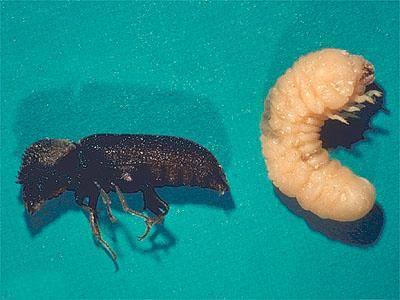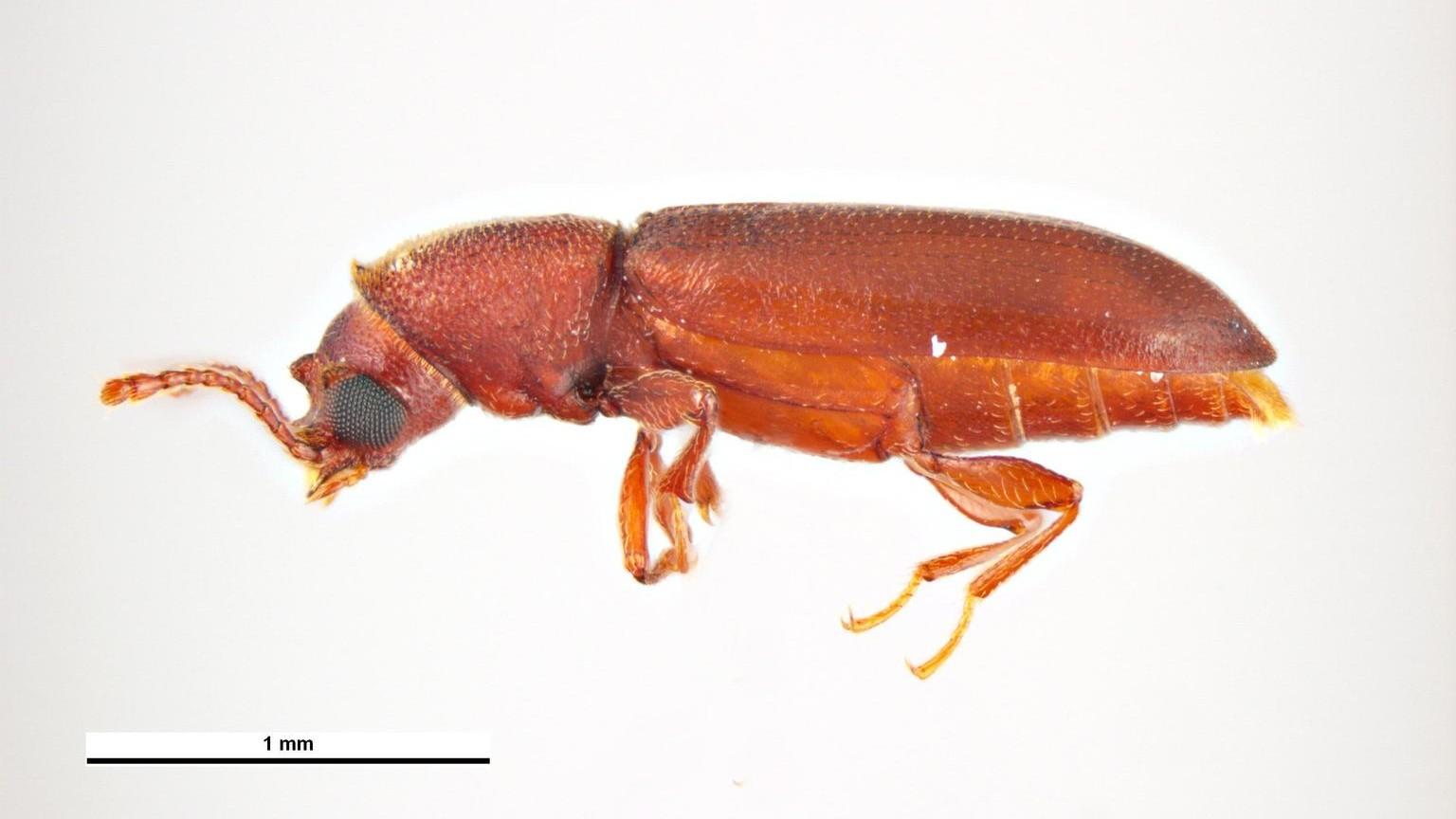About powderpost beetles
-
There are two main groups of wood-boring beetles: the old house borer which primarily feeds on softwood timber, primarily pine, and a variety of powderpost beetles, which prefer hardwoods. Beetles that bore into dead wood in homes instead of forest trees can cause structural damage if activity is left unchecked for long periods of time.
-
The name powderpost beetle describes several species of small wood-boring beetles.
-
The larval stages (worm or grub-like, immature stage) of these beetles are smaller than old house borer larvae. They are 1/4 inch long or less and whitish in color.
-
Hardwood floors and furniture, wood paneling, and trim are examples of places infestations occur. In addition to hardwoods, bamboo is susceptible because of its high starch content.
-
Finding a few beetles indoors does not suggest an infestation. The beetles may have been brought in on firewood or entered the home through an open window or door.

Powderpost beetle and larva. Photo: F. E. Wood
Life cycle
-
Adults lay eggs in cracks and crevices of exposed wood surfaces.
-
Upon egg hatching, small larvae bore into the wood and begin to feed.
-
Depending upon conditions, in about 2 - 9 months the mature larvae move to the surface of the wood.
-
Grown larvae pupate (transform into an adult) near the surface of the wood, then the adults chew their way out of the wood to mate.
Damage and signs of an active infestation
-
As the larvae feed and move into the wood, they carve damaging tunnels or galleries. In the tunnels, they pack frass (sawdust-like insect excrement and wood fragments) behind them. Fresh-looking, fine frass outside or near the exit hole or on the floor below may be visible and is a sign of an infestation. If the piles of sawdust reappear in a few weeks after it has been cleared away, the infestation is active.
-
Especially in spring and summer when wood moisture is high, rasping or clicking sounds made by large larvae can be heard from infested wood. Stethoscopes are sometimes used to diagnose an infestation.
-
Damage is also indicated by exit holes made when adult beetles emerge through the wood surface. Powderpost beetles leave round exit holes that range from 1/32 to 1/8 of an inch in diameter.

Fine “face powder” boring dust produced from tunneling ash log. Photo: Whitney Cranshaw, Colorado State University, Bugwood.org
Management
-
The larvae of wood-boring beetles work slowly so there is no need to take immediate action. You can take weeks or even months to evaluate the infestation and gather treatment options.
-
If the infestation is contained to one or a few pieces of wood, removal, and replacement of the wood is recommended.
-
If the infestation is wide-spread, hard to access, or it is not possible to remove and replace the wood consult with a licensed pest control company.
-
Some pest control companies will treat infested furniture or wooden art objects by placing the items in a fumigation vault or a large freezer for a period of time to kill the insects. A reputable antique dealer may also be of help in locating this service.
Tips on preventing the introduction of wood-boring beetles
-
Inspect timber and wood products introduced into your home for emergence holes of wood-boring beetles. Wood that is properly kiln or air dried is less likely to be infested.
-
To speed firewood drying, debark and split it and store it away from the house.
-
Install proper ventilation, dehumidifiers, and drainage systems to reduce moisture levels within and around the house.
-
Apply wood varnish, shellac, or paint to fill small cracks and crevices in the wood, eliminating places for egg laying.
-
Borax-based products can be applied to untreated susceptible wood as a preventative measure.
Based on UME publication 689 Wood-Boring Beetles-Old House and Powderpost Beetles, authors: Nancy L. Breisch Ph.D., Research Entomologist (Retired) and Barbara L. Thorne, Ph. D., Asst. Professor, Entomology (Retired), University of Maryland College Park.Compiled by Debra Ricigliano, HGIC, 2020
